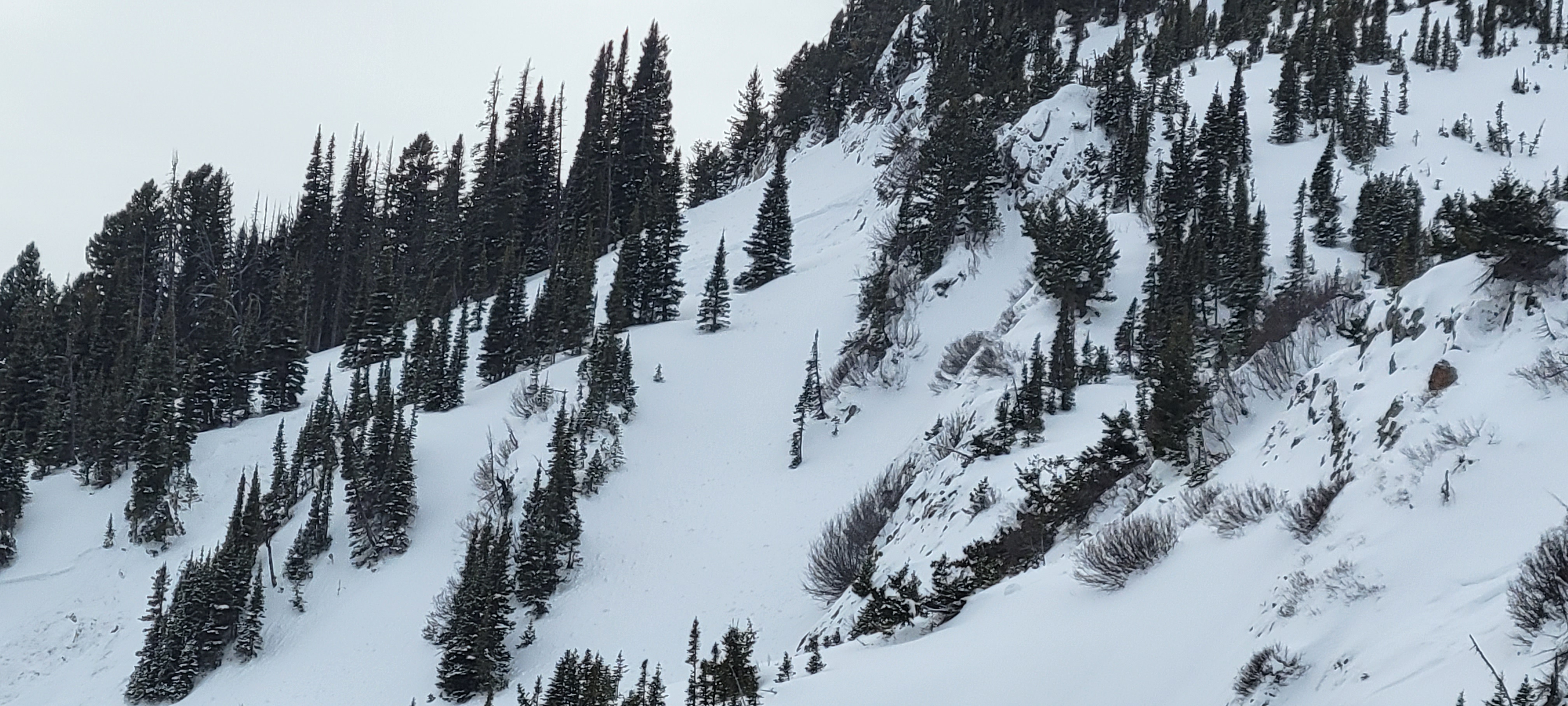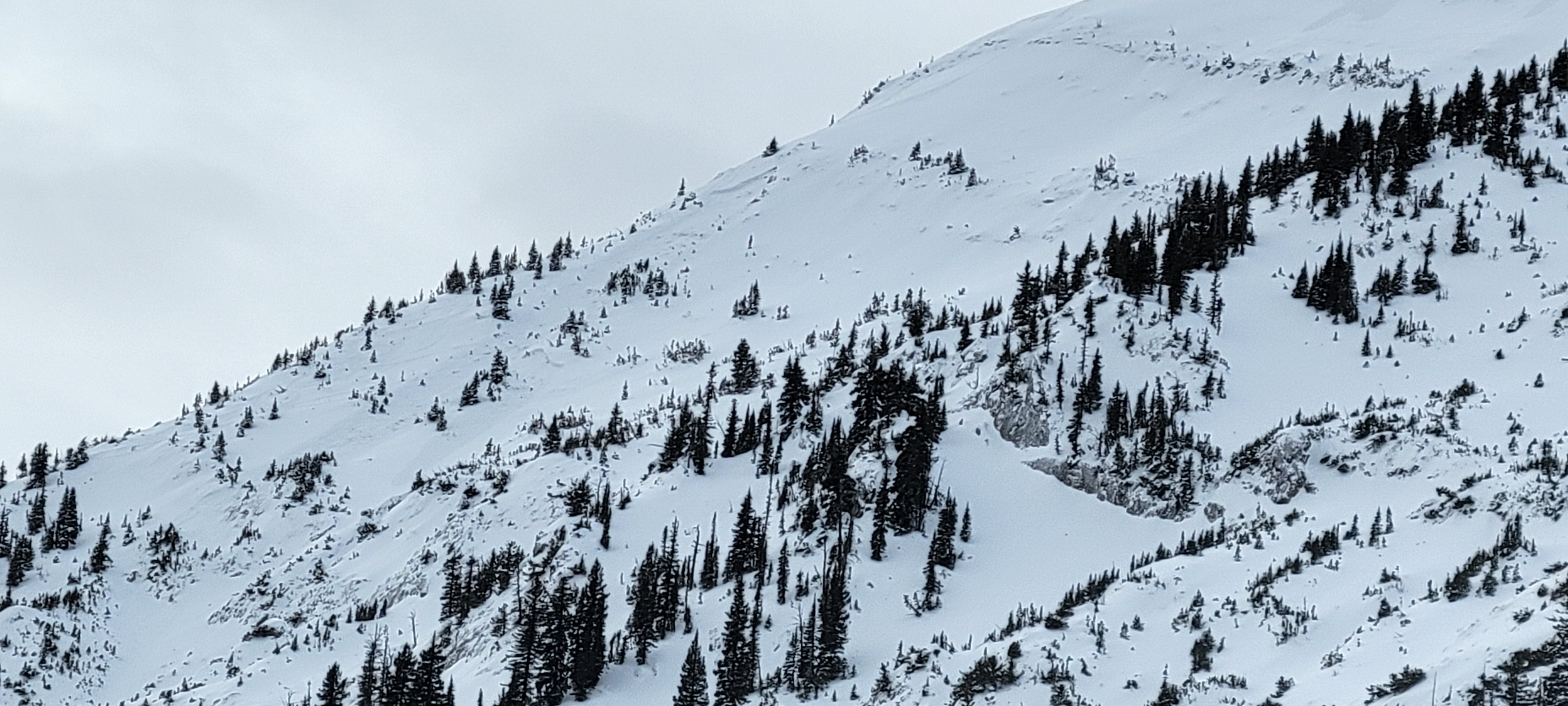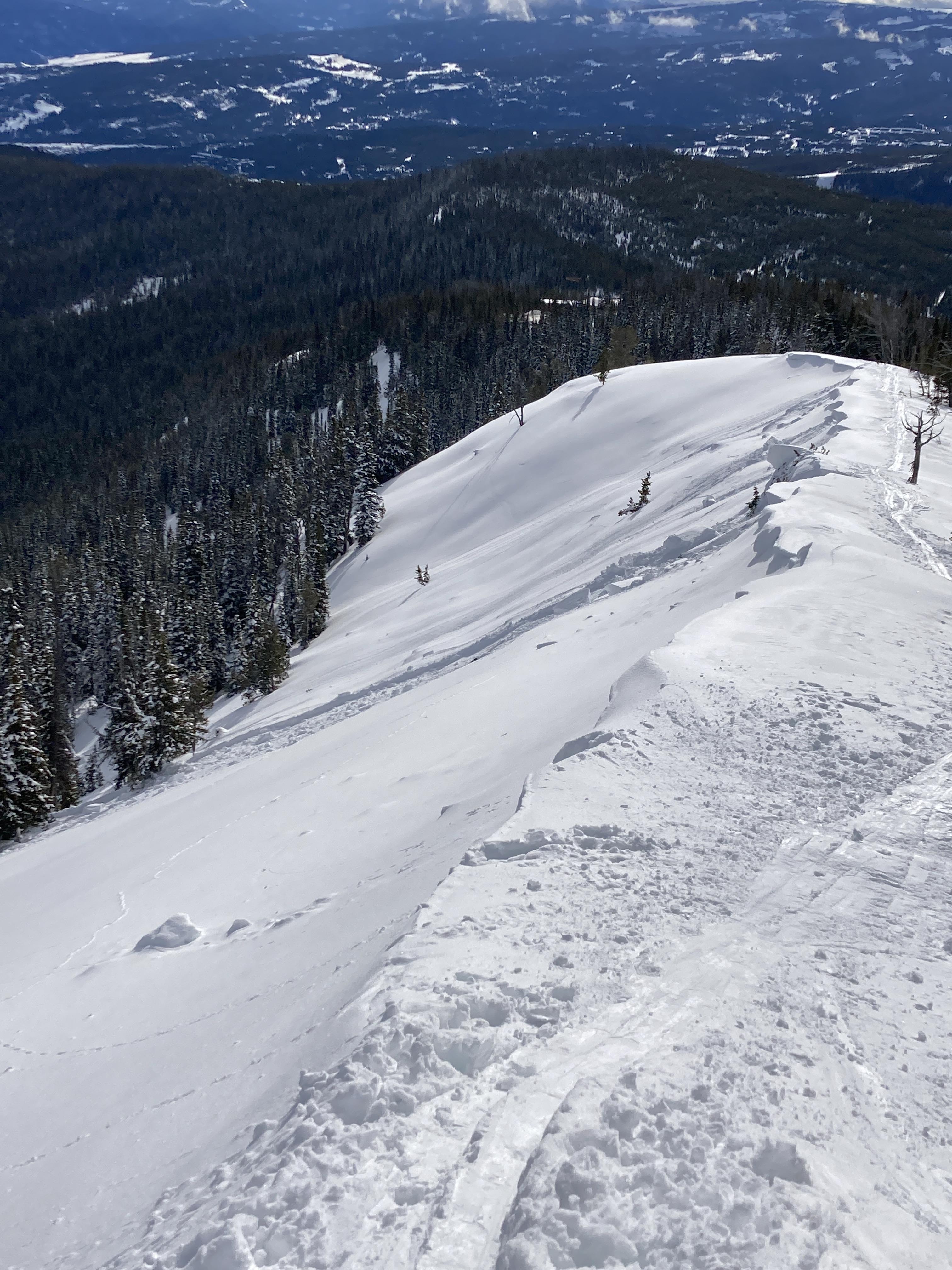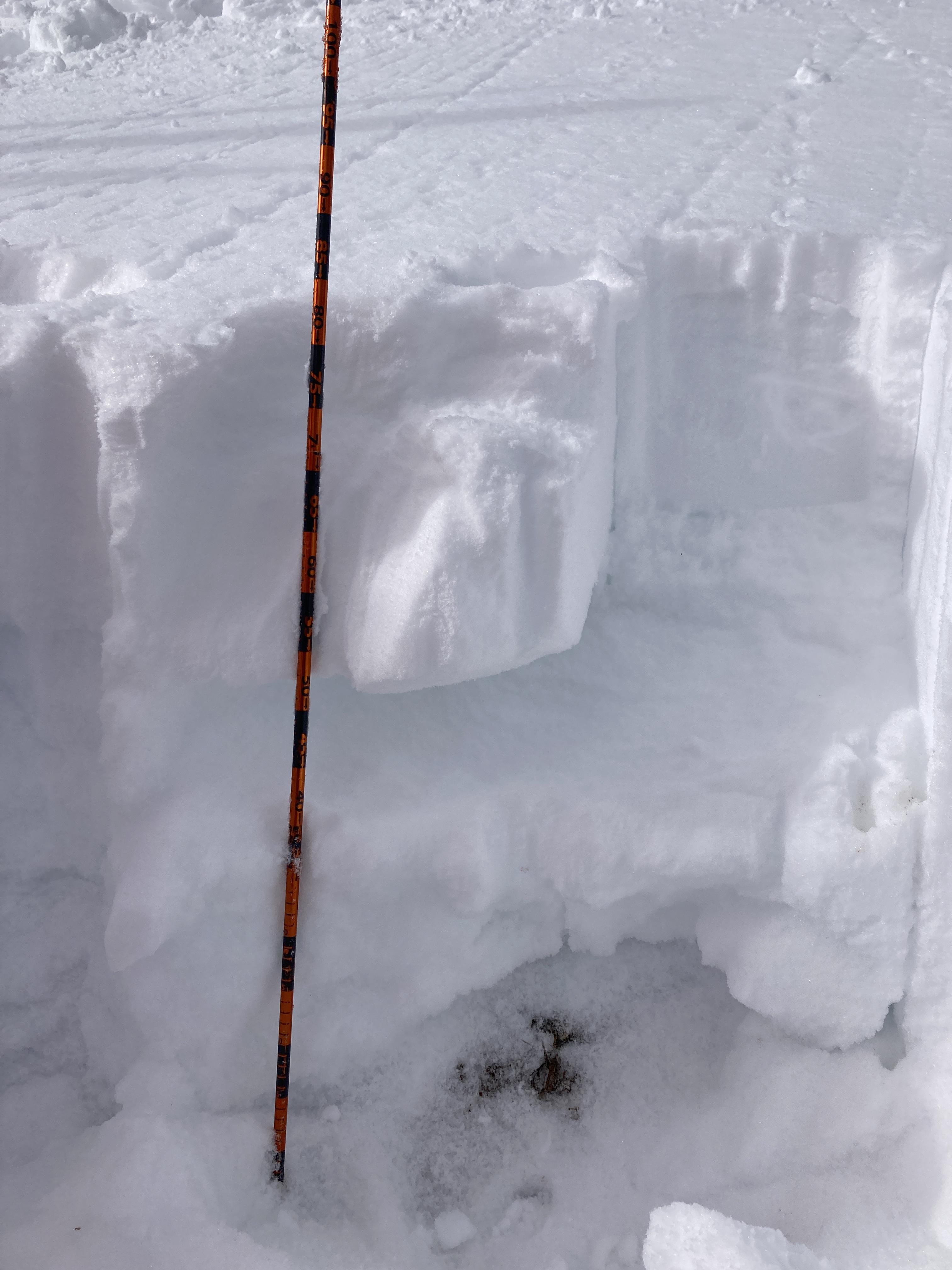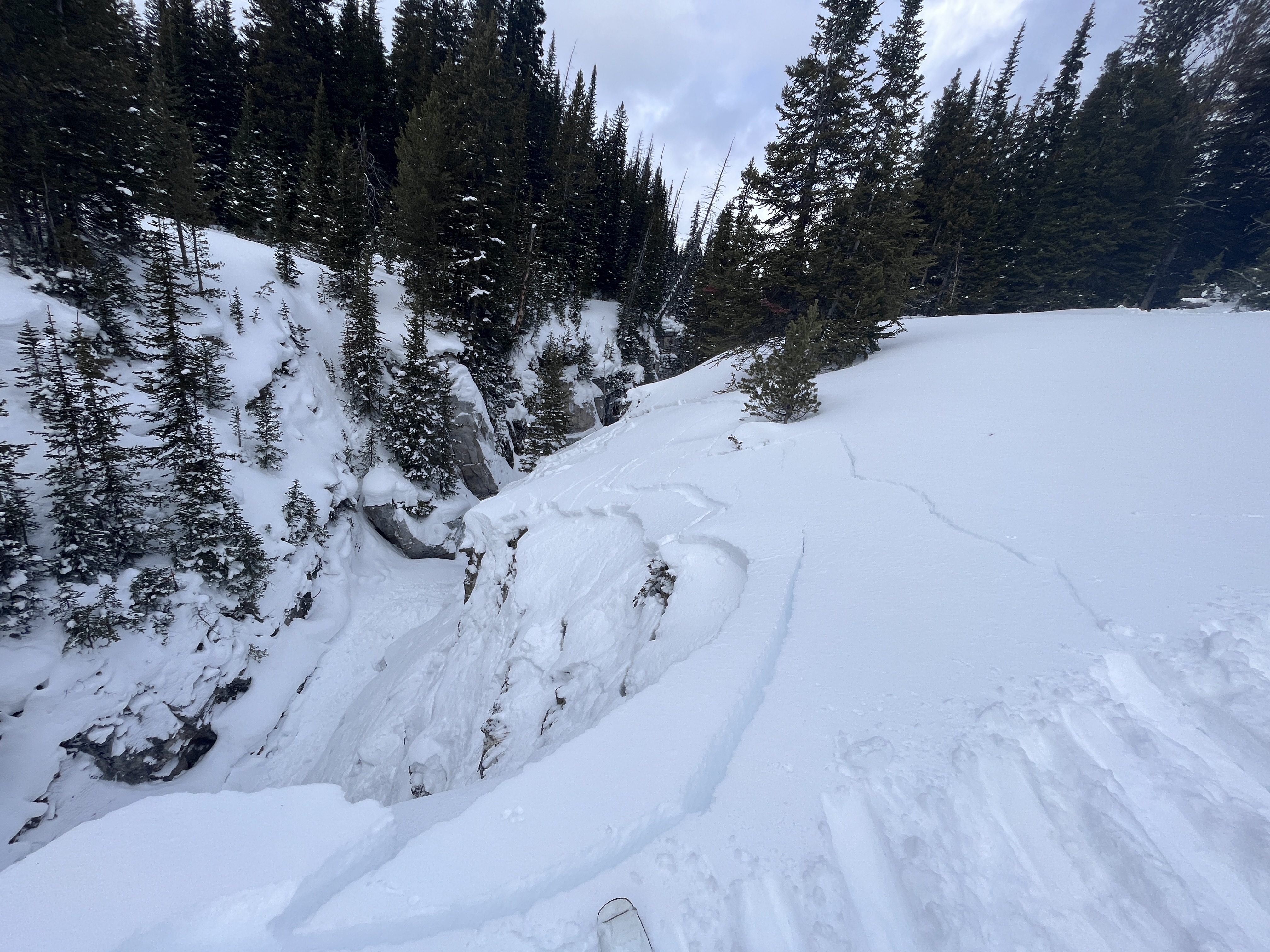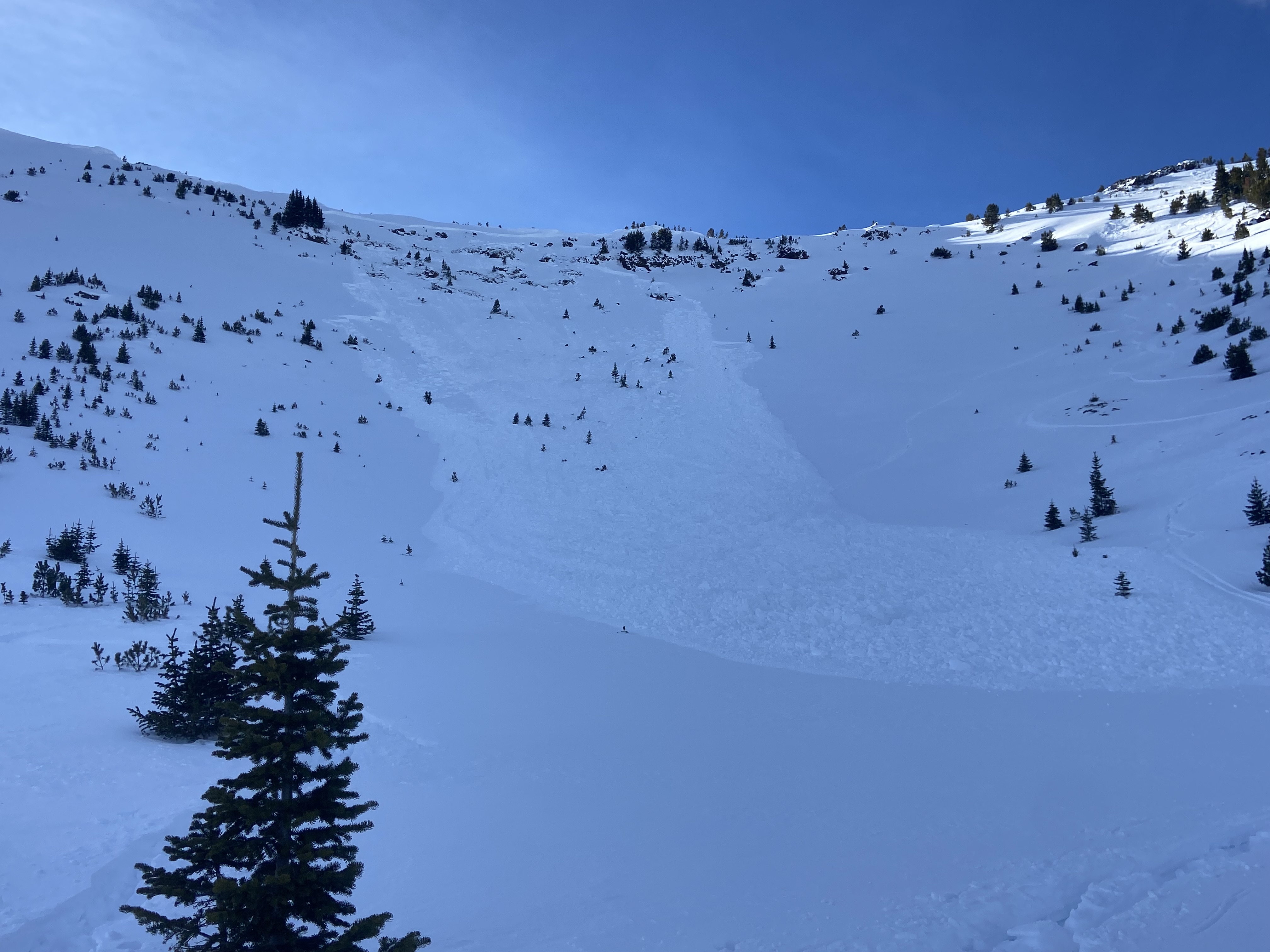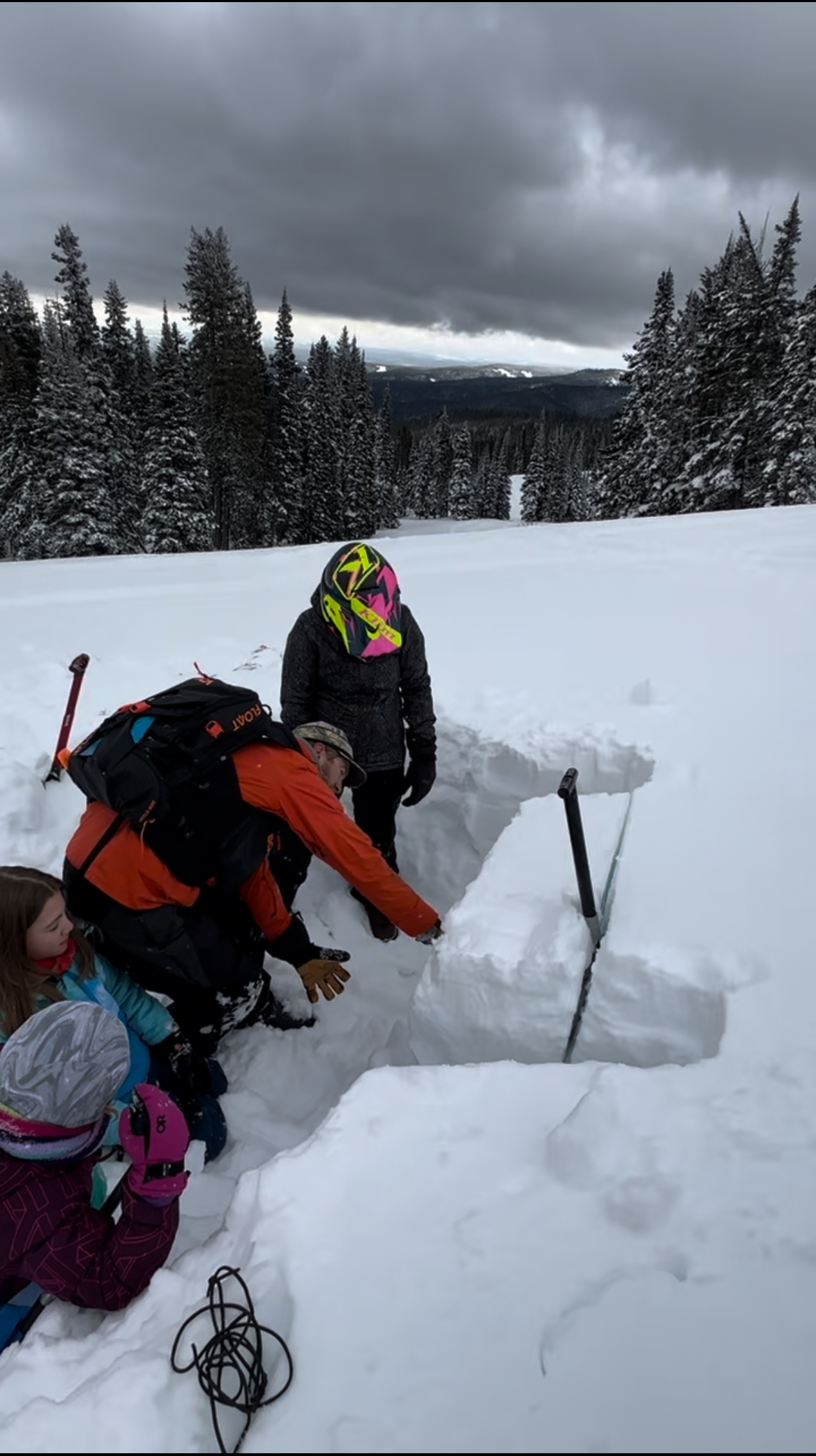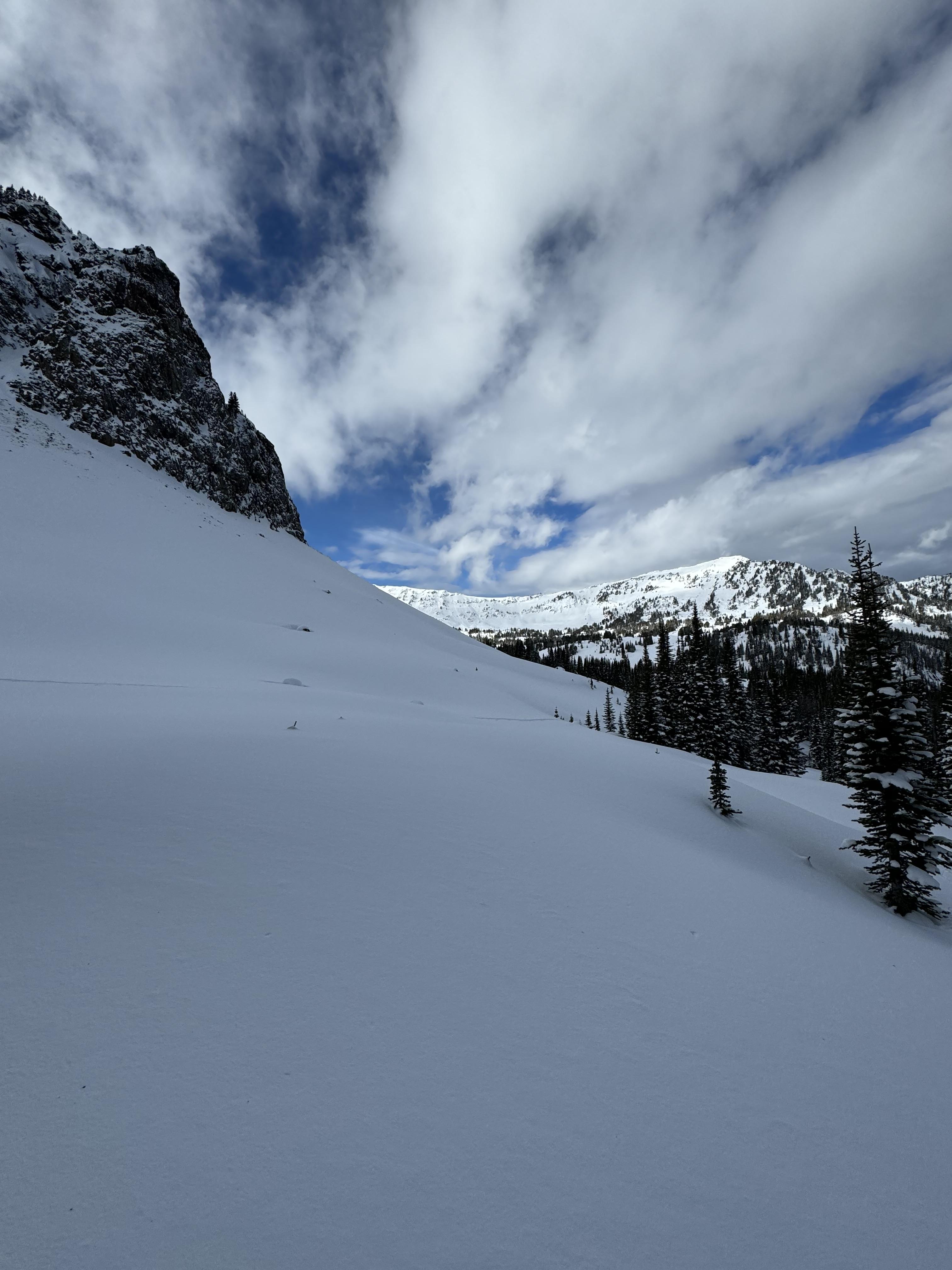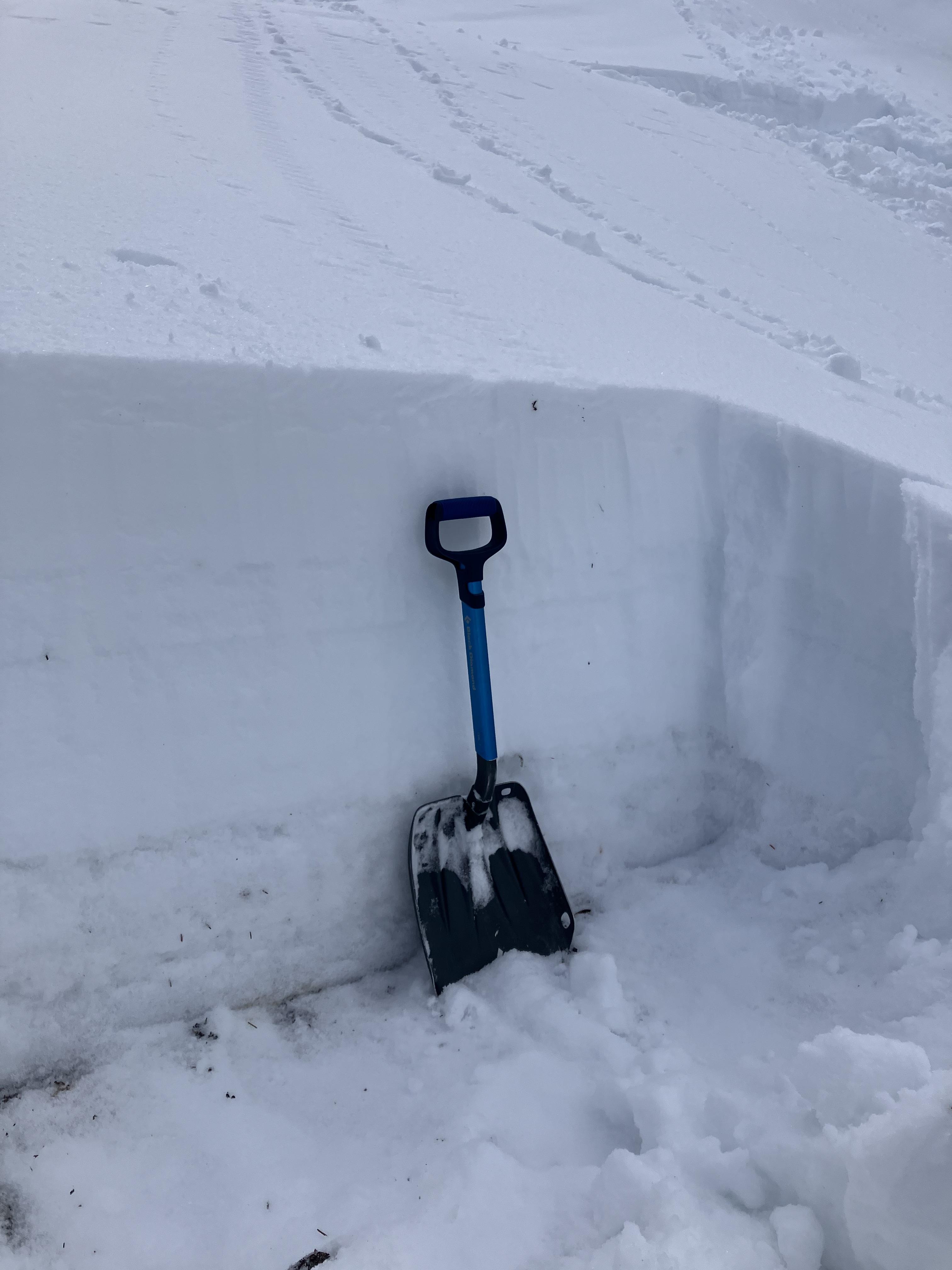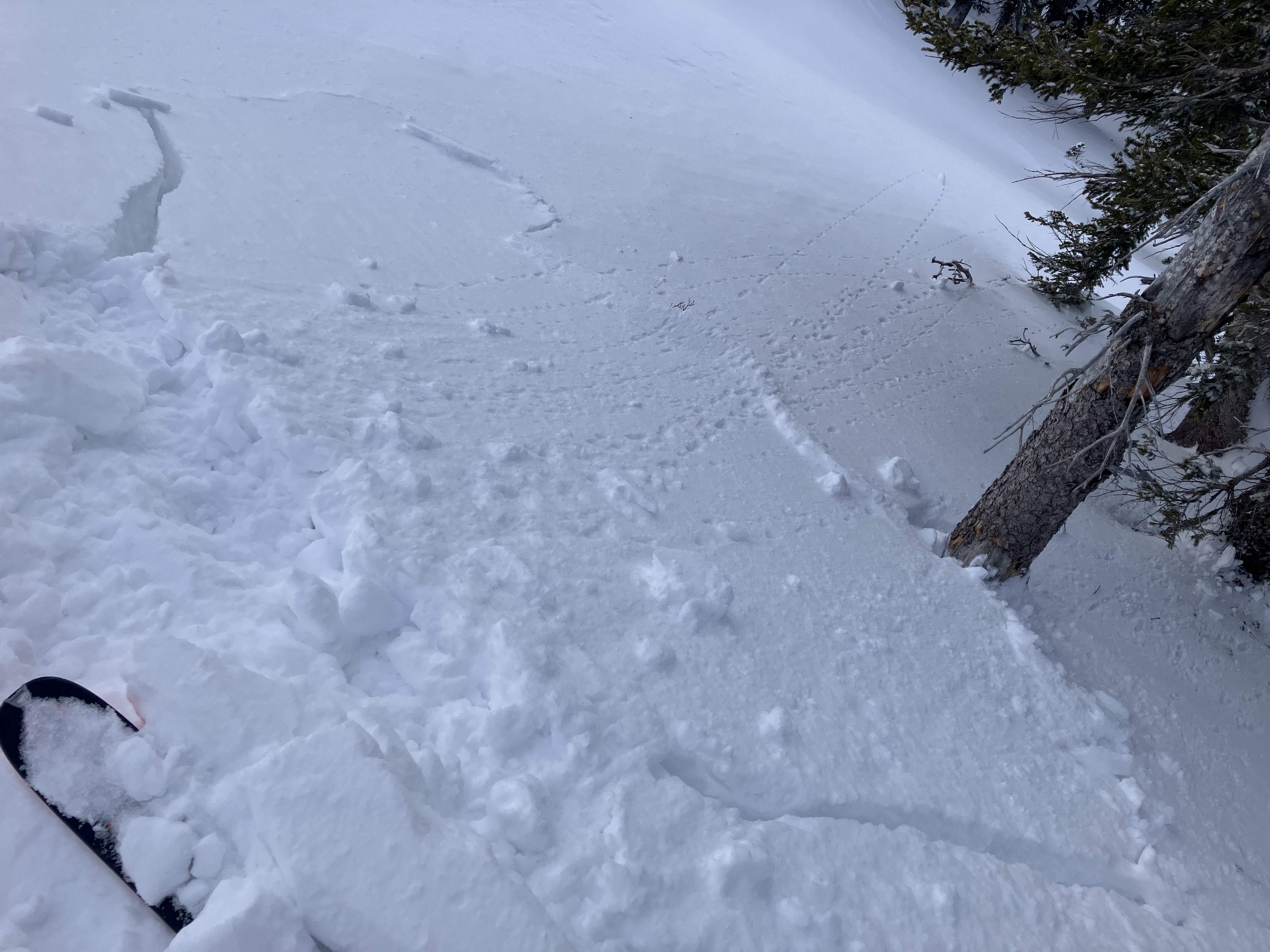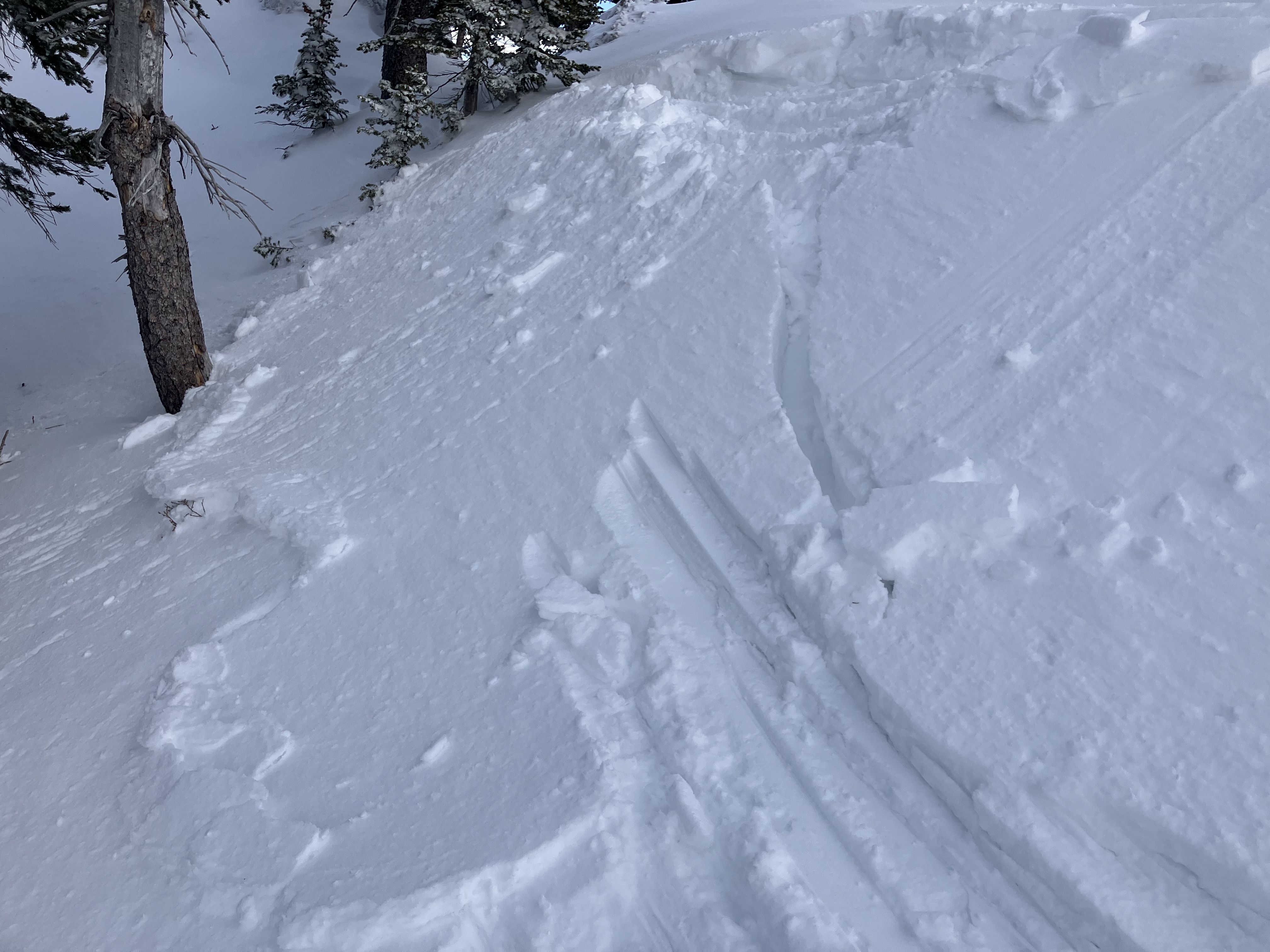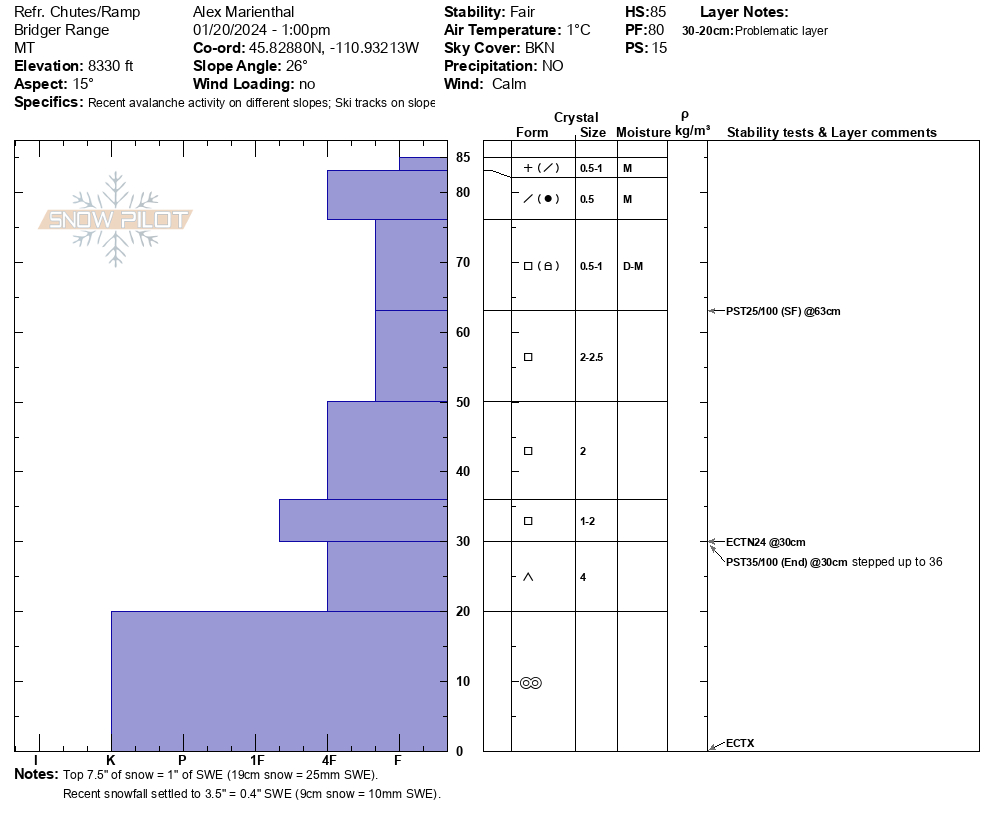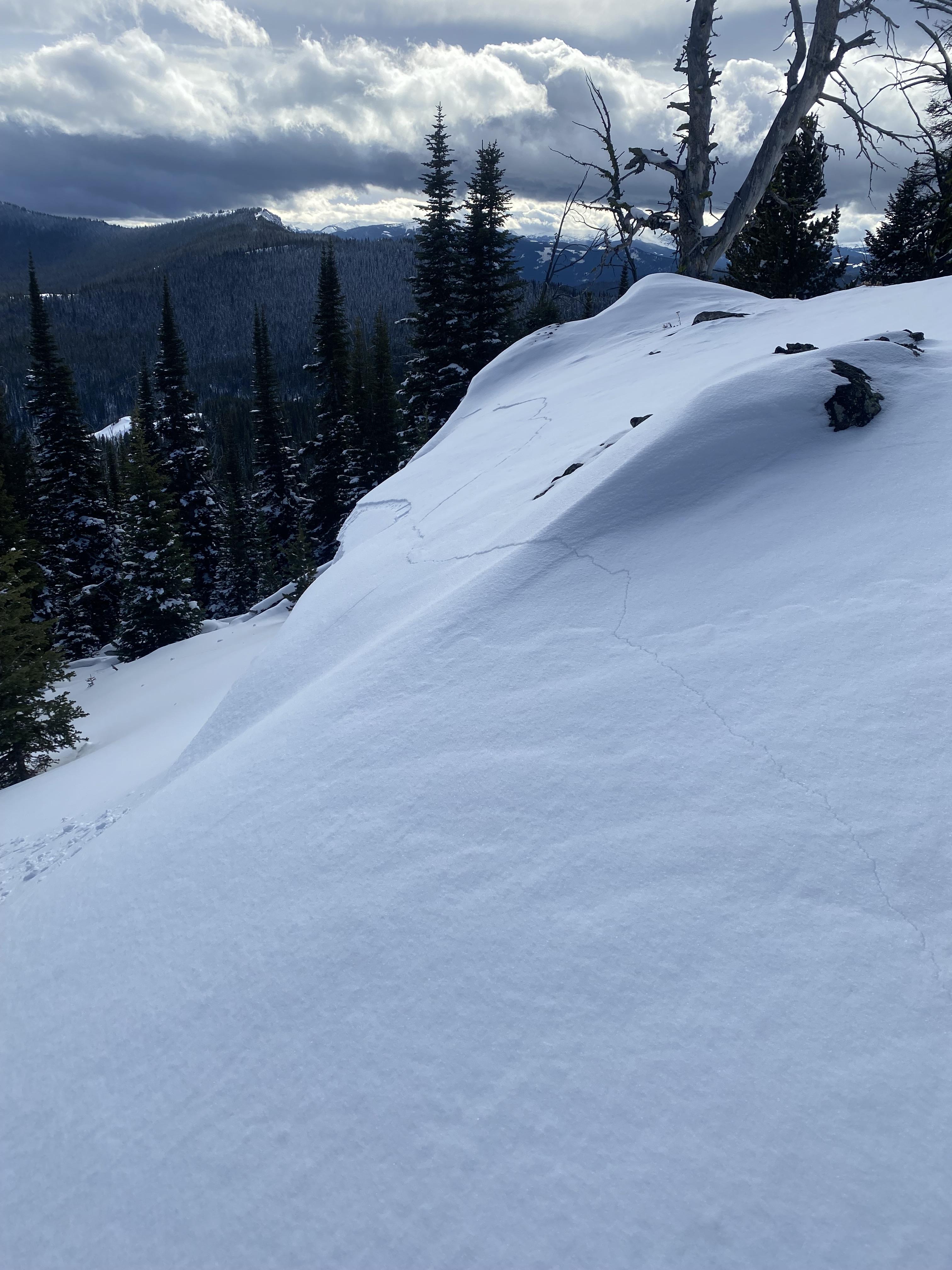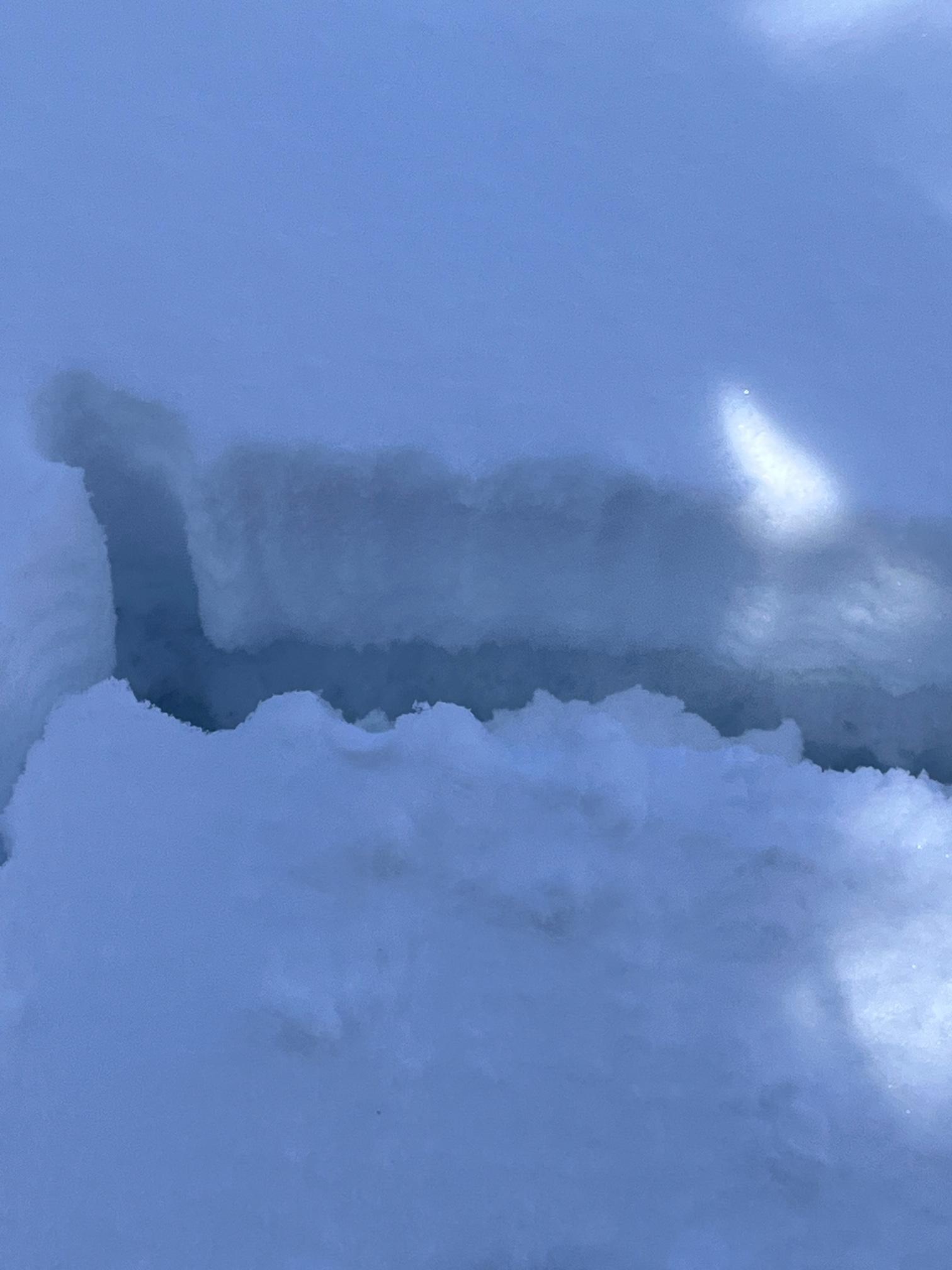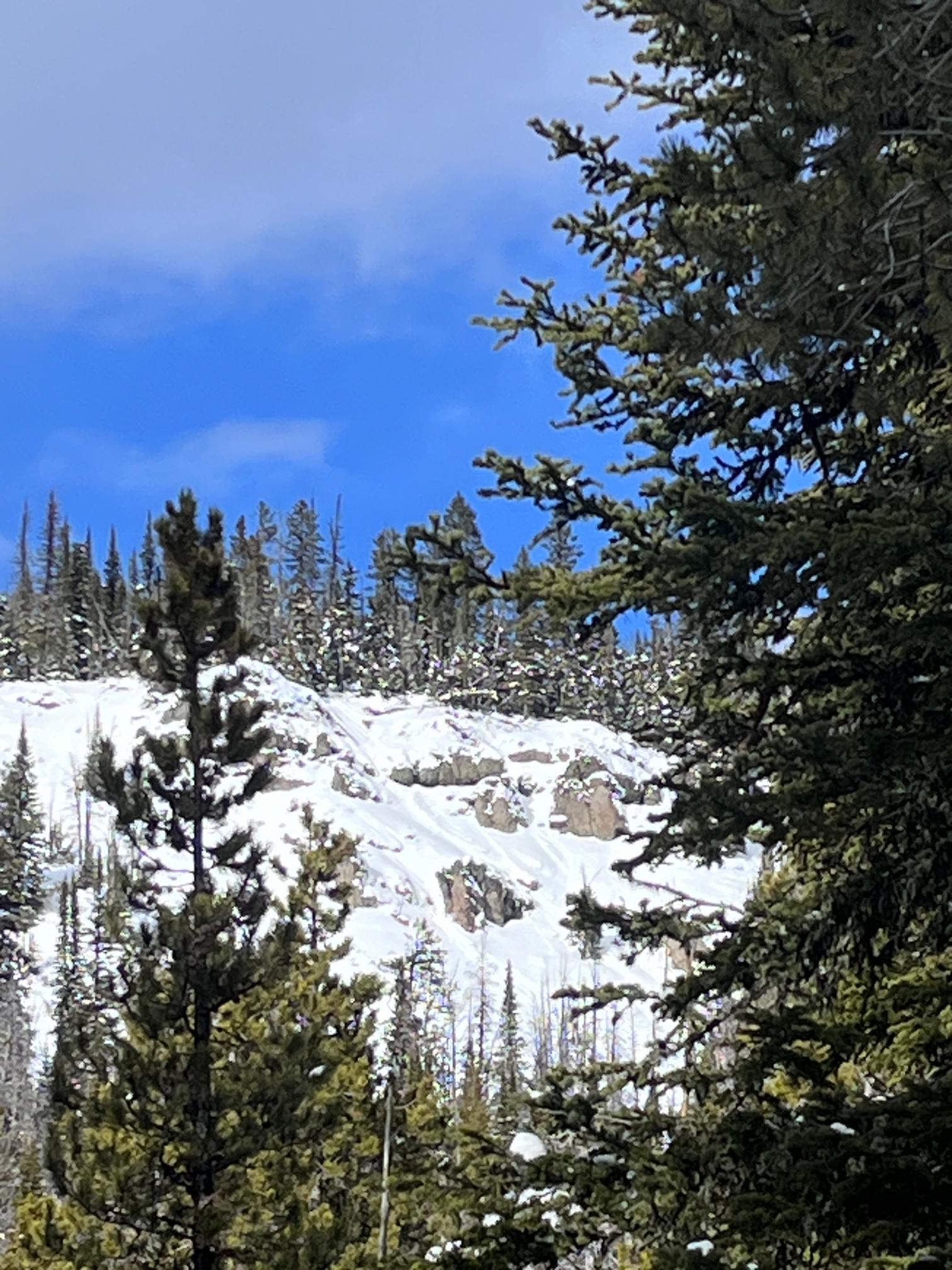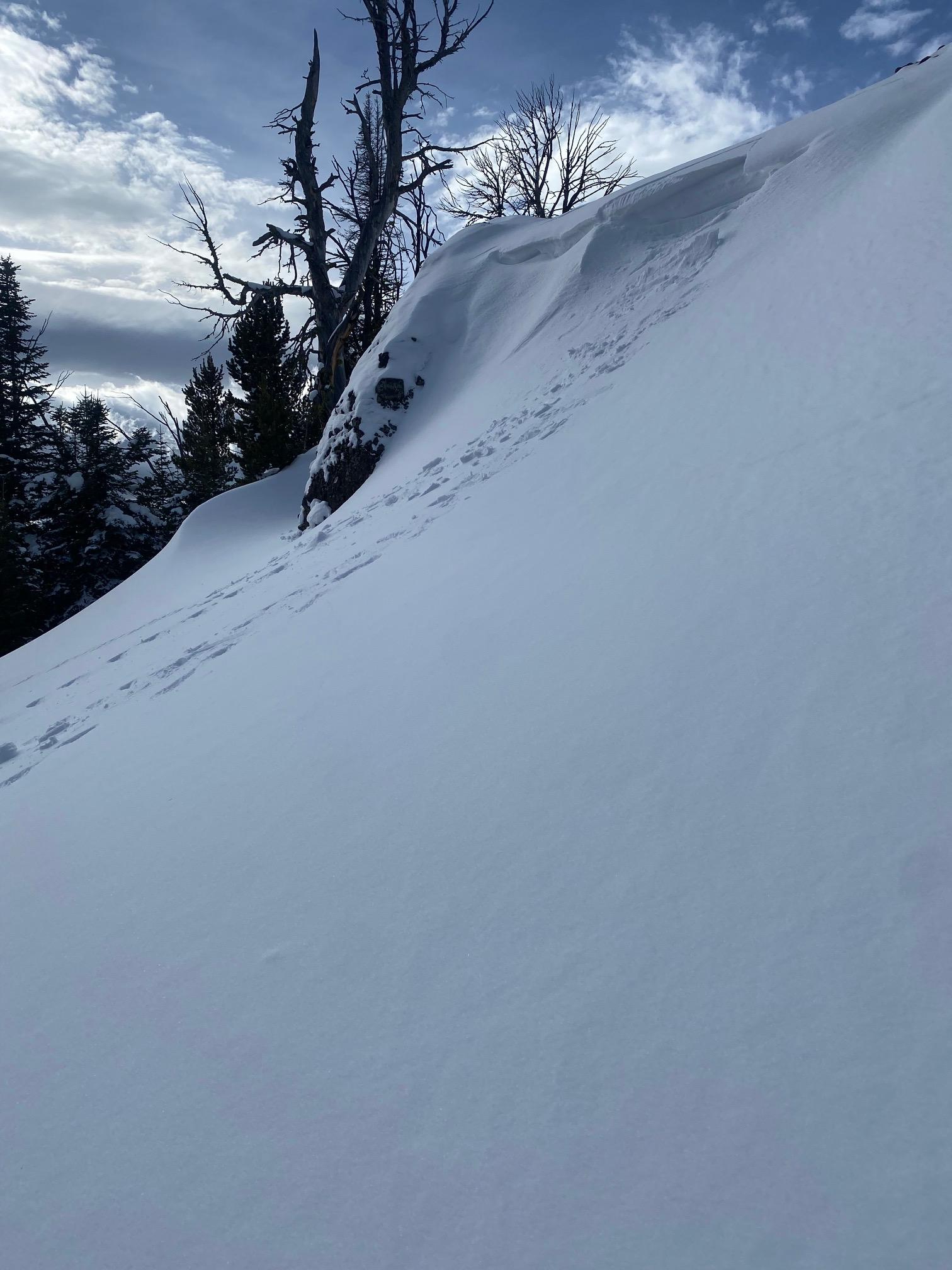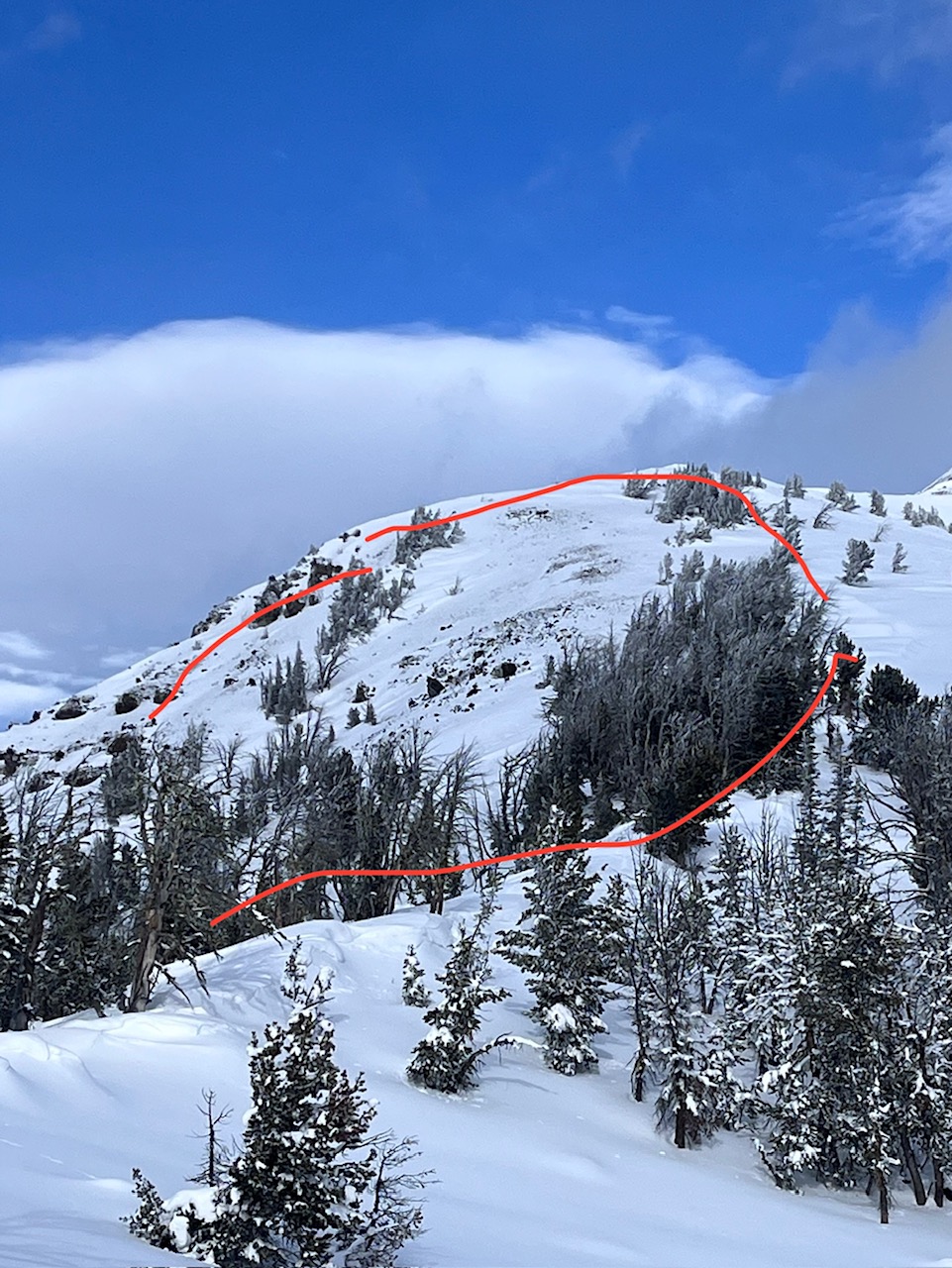Snow Observations List
From GCSAR and Bridger Bowl Ski Patrol:
A skier triggered a slide descending the skyline/nose of Saddle Peak. No one was caught. It initially triggered at the first rock band, then pulled out much wider at the second rock band. The skier was on his second lap was the third set of tracks on the peak. All tracks were accounted for and a beacon search of the debris came up empty.
Depth was described as "full depth" (2-3') and running on the depth hoar.
Crown was 80' wide on the first horizontal band and 500+' on the second. The lower crown wrappped around the ridge out of view.
Full Snow Observation ReportPete M and Jason H went out there. I talked to Pete and Graham (dispatch).
Quick skin up to the top of the far south Telemark Meadows point. Lots of thumping in the flat untracked areas up the the top. Cracks not easily seen as dense snow covered them as they spread. Quick Pit, 45cm depth. About 4" of new heavy snow on top of yesterdays sun drenched layer. Below lots of loose facets and 2 distinct frozen layers buried 15-20cm below surface to the ground. 0.3" SWE last night. 24 degree slope, south facing. Air and Snow 30F.
Full Snow Observation ReportMy partner and I remotely triggered a persistent slide on an East facing slope at 9350ft. The slide ran off the Evil Twin ridge, just below the large main summer trail bowl of Hyalite Peak. My partner and I were spaced out ~50ft when we both felt and heard a large whumpf. We looked up and saw the avalanche slide, but were both out of harms way from the path. The starting zone was ~400ft above us and the slide ran ~500ft in total length. The crown was just over 2ft deep at its max and 150ft+ wide. The were signs of recent wind loading as we approached the bowl prior to the slide. We did not observe any other avalanches while we were out. Got a couple nice turns in the approach meadows on our way out.
Full Snow Observation ReportSkied beehive basin and dropped into bear basin early this morning before the warm up, about 1-2" of fresh. In a early morning pit on the bear basin side near the top of the ridge we didn't get propagation but got cracking on hit 5 of our ECT. Noted a slab over facets buried ~ 50 cm from the bottom, with another slab and facet combo below that to the ground. ~90 cm total depth. As it warmed up other groups reported collapsing as they came up and we also saw the aftermath of a remotely collapsed cornice.
Full Snow Observation ReportI toured in beehive today around the wilderness boundary and summer trail, riding and digging a pit on the E aspect (left side)as I was skinning toward the lake. There was about 90cm where I chose to do my profile. Got CT 2 SC Q2 shear 70 cm down. I got ectp11 at 30 cm down. Talked to a seperate group of 2 splitboarders that came up skinning behind me, they had just dug a pit probably 50 ft below me, they also got ectp11. I saw a skier triggered slide on Tyler’s hill (lookers right of prayer flags gully), as I skinned in (ss-as-d1.5-r1-u). It looked like it propagated across about 25 ft and just pulled out on the single roll over, I didn’t get real close, and figured a picture from that distance with trees in the way might not show much. Had skin glopping going on, most aspects on my split ski out had a crust on them, but that’s lower elevation.
Full Snow Observation ReportWidespread cracking and collapsing were observed both north and south of Cooke City.
North of Cooke City Level 1 snowpits:
Got multiple ECTPs 12-17 taps, 65 down. Got one ECTV. HS ranging from 110-165.
9820' SW, Aspect, ECTP16 60cm down on small grain faucets
South of Cooke City Level 1 snowpits:
Dug a total of 7 pits throughout the day and 5 got propogation <5. Failing on the same SH/Facet layer 30-45 down
South of Cooke City numerous avalanches were observed on E, W, and Northern aspects. These all likely happened during or following a recent storm on 01/18. We stepped off the skin track and remotely triggered a small slope above the creek below. Took a closer look and it failed on surface hoar/facets 35 cm down. A skier-triggered avalanche was also seen on the west side of Woody Ridge.
Full Snow Observation ReportNaturals on most slopes, small in size for the most part. Poor lighting but the terrain near the climax also went.
Other emails from BPG:
Nina: Wow, nice! The last time that slope was remote triggered was in Feb 2017 at the beginning of the historic avalanche cycle. Forrest dug a pit a few steps below the skin track and remote triggered that slope.
Gloria: yah Zack was pumped he kept saying, I triggered Forrest's Avalanche!
Ski toured to west Woody Ridge today, south of Cooke City.
We set a new skin track and I would estimate that 80%+ of the snow we touched created a large collapse/ whompf. Many of the collapses were large and loud (over 100' wide). It seemed like remotely triggering an avalanche would have been easy/ likely had we been connected to steeper slopes.
We noted widespread avalanche activity in a nearby gully (NW aspects) adjacent ski tracks from yesterday.
In our snowpit at 9700', on a westerly aspect, we had an ECTPV. On 2mm facets, 45cms down.
I've skied that area a lot over the last 15 years, commonly during big snowstorms and elevated avalanche hazard, but today seemed like one of the most hazardous, if not THe most hazardous days for avalanches I experienced there- given the widespread nature of the PWL and thickness and sensitivity of the slab.
The warm temperatures today likely had a significant influence on the instabilities. (35 deg F in town for much of the afternoon.) Lots of roof-a-lanches noted today as well.
Full Snow Observation ReportFrom BSSP 1/20/24: "There were large avalanches observed on Cedar Mountain, on northerly aspects. Slides appeared to
be running on basal instabilities deep in the pack."
From email on 01/22:
"On 1/20, we toured north of town into sheep creek to ski the north-facing burn glade. We saw no new avalanche activity, but continued to experience numerous collapses as soon as we stepped off the skin track. The sun came out periodically in the morning, and that's all it took for the new snow to become much more wet and heavy. The denser snow was able to support the weight of a skier a little better and we subsequently experienced fewer collapses. Winds picked up from the west into the afternoon and began to transport a lot of snow around."
Full Snow Observation ReportSnow was heavy and glopping on our way up to the basin. Our plan remained the same all day - ski the skiers left trees of the SE bowl in Flanders. Once in the Alpine, lack of snow in the area led to slow, rock hitting skiing, one of our partners took a turn a bit more right of original ski line. I was waiting up higher in a safe position, and watched as he turned into the bowl, a remote triggered avalanche ripped out above him. He was fast to reach a safe position in the trees by the time the avalanche finished its ride. The photo shows the 3 ski tracks, and the most left one is what remote triggered above.
Full Snow Observation ReportWe reached the east ridge of beehive basin at 11:30 and it was warming up quickly. We considered skiing east into middle just before the prayer flags, but when approaching the slope to dig a pit we got a significant collapse and decided to ski a more conservative pitch further north. When continuing north on the ridge we saw a recent cornice collapse which triggered an avalanche, size unknown but pictured here. The conservative east slope was in the shade and skied well.
on the way out we got another sizable collapse when skiing west down from prayer flags, on the shallow, sunny western slope, when I edged out of the gully at the first dog leg to regroup with the party.
Full Snow Observation Report
Snow warmed up significantly and felt heavy compared to a few days ago. Dug a snow pit on on an easterly slope. ECTP 11. Didn’t notice as much cracking as a few days ago.
Full Snow Observation ReportWhile skiing into Beehive Basin from the ridge between Beehive and Middle basin we noticed some sizable natural wet loose avalanches. West facing, around 9000 feet, 10-12 inches deep, ran ~150 feet, observed at 2:15 pm. The new snow from last weeks storm had warmed and slid on the weak snow below.
Full Snow Observation ReportObserved several natural avalanches on the ridge above the cabin in Cabin Creek. Also saw lots of shooting cracks and triggered a small slide on a short steep hill.
Full Snow Observation ReportMy partner and I were traveling along the ridgeline separating Beehive and Middle Basin. 60 meters before the prayer flags on the ridge, we were stomping on the cornices. We heard a very loud whumphf and the cornice directly below me fell. This and our stomping triggered shooting cracks along the ridge and remotely triggered a cornice 30 meters ahead of us. This cornice fall triggered a hard slab avalanche that was about 15 meters wide and ran at least 100 hundred meters, but we could not see the terminus in the trees. The crown was 1F wind slab failing on facets 35 cm deep. It immediately stepped down to basal facets in spots with total crown depth of 75 cm.
We dug a pit several hundred meters further down the ridgeline in a more representative area. See attached for snowpilot and picture of large chained depth hoar at the ground.
Full Snow Observation Report
Skied two low angle meadow laps. Continued up towards Hyalite. Consistent whumphing when breaking trail. We dug a pit a bit before the first steep rollover on the way to Hyalite Peak (~9200’). ECTP18, broke 50cm deep where the storm slap interfaced with facets. Total depth 130cm. Consistent beefy storm slab underneath 4-5” of fresh snow once out of the thick trees. Snow so unsupportive we couldn’t walk 15 feet to dig our pit.
we also observed signs of recent natural avalanche activity in Divide Basin
Toured up the Ramp in the Bridger Range. At the top of The Ramp/Wolverine I pushed on some small wind-loaded terrain features with skis. About three inches of soft snow moved/cracked no wider than my ski width, then one step lower a hard slab cracked out about 10' wide, 10-12" deep and did not move more than a few inches downhill due to flatter terrain supporting it below. The slab was pencil hardness which leads me to believe it was older than the last snowfall on Wed-Thurs, but possible it formed during that event if there was a period of moderate-strong wind at the ridge. I had two other terrain-feature sized "whumphs" on similar small wind-loaded slopes directly adjacent. These hard slabs were sitting on sugary facets, and show that avalanches can be triggered on previously wind-loaded slopes. While these were small, a similar size slab on a steeper slope could easily take you for a ride, and larger avalanches are possible on larger wind-loaded slopes.
Warm temps made the recent snow moist and denser, feeling more like a slab, but there was not quite enough recent snow on non-wind loaded slopes to get much cracking or propagation in tests. There were small cracks on the surface, but did not travel beyond shovel or ski width. A pit at 8,300' on a northeast aspect showed a very weak snowpack with generally stable test scores. and we had ECTX and ECTN results, a PST 35/100end at 30cm above the ground, and PST 25/100slab-fracture below the recent snow at 63cm above the ground. Snow depth was 75-85cm.
There were natural rollerballs on most aspects initiated from warm snow falling off trees. Possible recent small-medium slab avalanche (8-12" deep) on the west side, behind the Patrol lift, but didn't get a great look. There were rollerballs on that slope which may have triggered a slab?
Temperatures were above freezing and it was raining below 8,000' at 10am. Snowing above 8000' briefly, accumulated to 1cm. Calm wind. Partly sunny by mid-afternoon. Skins were glopping bad off the heavily used skin tracks, and moist snow surface will become a melt-freeze crust on most aspects, possibly with the exception of a few slopes at the highest elevations.
Full Snow Observation ReportWe experienced widespread whumpfing on all aspects between 7200'-10200'. Solid slabs were also widespread, ranging between 4''-12'', all of which were sitting on facets. We dug many handpits and the results were extremely reactive, often propagating while cutting the pit. We did not observe any natural slides. We remotely triggered a cornice and large slab, but it did not run due to the slope angle. I'm certain if we ventured into or near steep terrain, something would've run. Between 7200'-9000' we saw many wet loose on slopes > 30, and set off large roller balls on most slopes. Down low it was very warm and felt like an early spring snowpack. From 9000'-10200' it was much colder and wind slab/board was widespread on E & SE aspects. Every aspect we touched up high had shooting cracks and loud whumpfing.
Full Snow Observation ReportToured Ramshorn Peak from the rd. closure in Tom Miner basin. On approach we observed continuous wumpfing and shooting cracks from 7,500' to 9,900'.
A hand shear on a 20° slope with a SE aspect at 7,800' sheared cleanly upon isolation. This hand shear was completed in a rather shallow (~10") snowpack, with large facets below a slab of thicker, fist dense snow.
Large roller balls were observed in avalanche terrain on a SE aspect at 8,300'. Alongside this observation, rather wet, sticky snow was observed throughout the tour, causing multiple glopping incidents on our skins.
A second hand shear was preformed on a E. aspect, 20° slope around 8,400', which easily sheared clean with light hand pressure. This snowpack was notably thicker than the previous hand shear location, measured closer to 30" with facets below a 6" slab of fist-dense snow.
Near our second hand shear, a 2' cornice on at 27° slope created a large shooting crack that propagated across the whole slope (contained by trees). If said cornice and slab was on a steeper slope, we are pretty sure this slab would've slid.
A several day old avalanche was also spotted on the windward portion of Ramshorn's SW shoulder around 9,800'. Upon further inspection, this slide seemed to be natural and had a crown of ~1.5' with a width of approximately 300'.
Clear evidence of recent wind events (e,g. Thursday's 75mph gusts) were clear on the SE face of Ramshorn, creating several inch thick wind slabs on the face and removing the majority of the snow above from the SW ridge and peak above 10,000'.
Full Snow Observation Report
